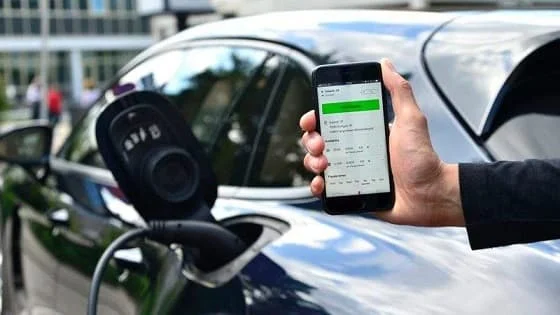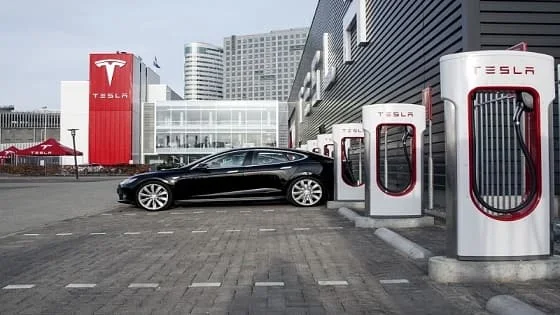California is moving towards German Eichrecht | Mandates KWh display and bans per minute billing
Effective 1st January, 2020, California will adopt an amendment to their Electric Vehicle Fuelling Systems Specifications (Ref: CDFA), which highlights two important updates:
➤ No more per minute billing: Charge Point operators are mandated to bill their customers only for the KWh electricity consumed during a charging session. This means, “per minute” as well “per session” billing are banned.➤ Mandates KWh display: EV charging pole / stations must have a display on the spot, that shows the kilowatt-hour consumption for every session. This is applicable even to the existing large install base of Tesla Superchargers.
In short, the state wants the charging pole/ stations to look like their counterparts – gas stations, where you pay only for what you consume (per litre of fuel) and where you can see in real time what you’ve consumed per fueling session. Calibration and security of the meters are still not defined, yet seems California is moving towards the German Eichrecht (M&E - Mess- und Eichgesetz) calibration law.
What's wrong with per minute billing?
“Per minute” billing may be beneficial for the Charge point operators, since it provides a means to penalize (bill) those who leave their cars plugged in for hours even after the car is fully charged, blocking further utilization of the charging station.However from end-user point of view, “per minute” is never fair. Below are the main reasons:
➤ Variance between EV’s charging capacity: Not all the cars consume the same amount of electricity in a given time; for example a Tesla Model X can consume upto 22KW in an hour, whereas a Volkswagen e-Golf can consume a max of only 7.2KW hour. Thus, it’s not fair to bill a Tesla driver and Volkswagen based on time the EV is plugged-in.
➤ Variance in State-of-battery, temperature & other parameters: Even between the same EV models, there can be many other parameters that decides the power they consume. For example: In a given time, a Tesla model X plugged in at 20% state-of-battery will definitely consume more energy than another model X that’s plugged-in at around 70% battery full; invoicing same amount to both these cars is also not fair.
➤ Non-transparent peak-hour handling & peak-shaving: Nowadays during peak hours, many of the charge point operators either reduce the charging speed via smart charging and/or invoice customer at extremely higher price. This peak-hour handling is very important to cope-up with increasing power demand on the grids, however, there is no transparency to the customers on how the invoice is calculated and how much the CPO reduced the charging rate.
➤ Non-transparent process on broken charging sessions: Not often, but at instances the charging session can get interrupted (stop for a few minutes and re-start) due to CPO back office communication, grid issue, or for many other reasons. There’s no clear process to handle these kind of intermediate-broken & restarted transactions too.
E-Mobility as selling “service” Vs. selling “electricity”
So far, the business model of most eMobility providers including Electrify America, ChargePoint, and EVgo are based on “per minute billing”(and some followed “per-session” billing). Most of these eMobility providers are not from utility background, and have built their business cases based on “per-minute” model. So obviously, they have been strongly advocating selling eMobility as a “service”, and did not buy-in the option of “selling electricity”.
The Measurement Standards Regulations authorities of California heard all these arguments from the eMobility providers, but after long investigations, decided not to agree to their arguments for per minute/session billing. You can download the FINAL STATEMENT OF REASONS for banning per minute billing, released by CDFA here. Below are the highlights / summary statements from the CDFA response.
The Department acknowledges this group of comments and disagrees with the interpretation of the primary commodity being traded. As defined in BPC § 13400(a)(4) and (p), electricity is considered a type of motor vehicle fuel. NIST Handbook 44 makes clear what the unit of measure of electricity as motor vehicle fuel dispensed from EVSE shall be measured by — either the kWh or the megajoule (MJ). The Department concludes that the primary commodity delivered by EVSE is electricity, not parking space accessibility, parking space rental time, or accessibility to the EVSE itself. The Department considers those as “other services” of the transaction. The Department clarifies that time is not an acceptable unit of measure for dispensing and billing electricity as motor vehicle fuel.
Transparent billing process via KWh display:
Being used to gas stations with transparent and comprehensible display of: the quantity of fuel pumped, price per litre, and total amount of consumption in every fuelling session, it is natural that a common EV driver would expect the same level of transparency while charging his electric vehicle too. Isn’t it?To my knowledge, Tesla is the only operator who has already adapted “kilowatt-hour consumption” based billing. But Tesla too have the other challenge of displaying KWh consumption on the station!. Tesla too is obligated to install a display on its huge existing network. Luckily, the law does not state that the KWh display has to be built-in the EV charging pole / station, but can be retro-fitted as an external device.











From my point of view, this is something the charge point operators should decide themself depending on the service they want to deliver to the customers. When you are on a longer trip and need to charge, it is a bad customer experience to wait for half an hour or more because someone decided to top up their car to 100 % on a quick charger.
ReplyDeleteIt can be a challenge for the customer to understand the actual kW price, but this can be solved by calculating and displaying the actual kWh price to in the screen of the charging station. This price will, of course, vary over the charging session.
It is very complicated to do fair pricing. I want to pay by the kWh on AC charging but on DC I want people to move the EV as soon as they have enough. Paying by the kWh on DC does not give people the need to move the car when the car charges low and this is an issue.
ReplyDeletePer Minute billing is a very bad idea, it brings various prices for different vehicles or by low temperatures. Pricing / kWh is the only fair system, the other problems like moving you EV is a cultural one which really should not be settled by charging different prices for the same technology.
ReplyDeleteDemanding display of KWh is good. Retrofitting existing chargers may a bit expensive, but is required to protect consumers basic rights.
ReplyDeleteImplementing German Eichrecht would bot be a little, but a lot more expensive. It’s overshooting the target and adds unnecessary costs to the system. Alternatives, like the threat of applying draconian penalties to offenders, would be cheaper.
I agree Dror Bar-Lev, Moving to eichrecht, that too while retrofitting old stations, would be extremely expensive for a large market like California.
DeleteDror Bar-Lev not so easy to implement. As a user of an EV it can be difficult to know exactly when my EV finish charging and when the “parking delay fees” starts. Tesla can do it because the car/charger/app is from the same company and can easy communicate.
DeleteHow can an Hyundai Ioniq EV with no app communicate with a many different charge point providers?
Martin Messer Thomsen , the app doesn’t necessarily need to come from Hyundai. It should be supplied by the CPO.
DeleteUse case #1: The driver already has an app which he/she uses to authorize charging. Problem solved. Roaming agreements could be extended to cover messaging.
Use case #2: Authorization is done without an app. A charger ideally would have a display (otherwise a simple sign) where upon authorization a message would be displayed informing that at this charging station a parking delay fee is applicable and which app could be downloaded to get a warning when charging has been completed (plus the duration of the grace period, let’s say 10 minutes). An opportunity for the CPO to engage the customer.
Use case #3: A driver refuses to download an app or a tourist without an international data package. These cases are rare and can also be solved (although less gracefully). If the charger has a display, an estimate of charging time could be displayed. No display? And no app? Very rare ... let the driver take a risk.
What do you think?